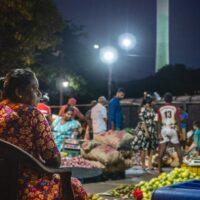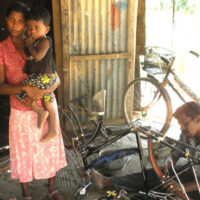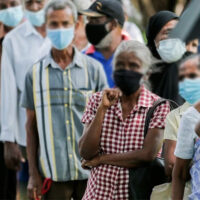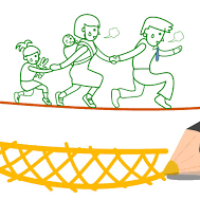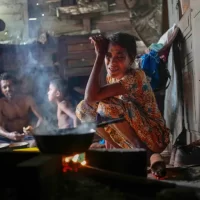‘There is no change or hope for us’: Gendered impacts of crises on coastal communities
By Nadiya Azmy
“Things have been incredibly tough these days. Soon, our children will die from starvation. I have been selling fish for 39 years and have never experienced anything like this. This is a punishment for us. We haven’t seen or heard anything like this. Even after these protests and resistance, there is still no change or hope for us.”
This is an excerpt from a conversation we had with a woman fish vendor at a Negombo fish market in June 2022. This conversation reflects the plight and sense of disillusionment of many others in the fishing community, affected by multiple crises over the last few years, and especially the ongoing economic and political crisis in Sri Lanka.

A fish vendor prepares to take the unsold seafood home, as consumers have reduced
Background
Sri Lanka is experiencing an economic and political crisis, with foreign currency reserves plummeting 99% compared to 2019. As a result, inflation is sky-rocketing and in July, year on year food inflation was 90.9%, up from 80.1% reported in June. Such a crisis and their impacts are felt by different social groups in varying ways. When members of such social groups are not at the table where ‘solutions’ are crafted, impacts of these shocks will remain cyclic, long-term and generational.
In this photo essay we present narratives pertaining to the current crisis in Sri Lanka. Our work focuses on fishing communities in Negombo, specifically the Pitipana, Palangathure, Kammalthota and Kudapaduwa areas. These observations were made between the 17th of May and 30th of July 2022, as part of a broader study focusing on ‘ruptures’ and their impacts on small-scale fisheries and fisheries value chains. We present the main themes that emerged during our work with respect to the on-going crisis, embedded within and compounded by a series of shocks that deeply affected the Negombo coastal communities since 2019, with a focus on the gendered impacts.
With no fuel, fishers have not been able to go to sea
Fishers have been unable to go to sea due to the scarcity of fuel; mostly diesel and kerosene. For context, a one-day boat requires 40 litres of fuel for one trip, while a multi-day boat requires approximately 8,000 litres per trip. With the rationing of fuel these vessels have been mostly inoperable.
“My husband used to go to sea using a one-Day boat. For the past 3-4 months we have brought it to land, because there is no fuel. Now he takes part in drying fish and supports other boats.”
Many one-day boat fishers told us that they have not received kerosene for months. Multi-day boat operators have been able to operate to a certain extent as there has been a limited supply of diesel. Some estimated that in general, the fleet out at sea is only 10% of the total. Others reported a reduction in the distance of their trips. Many expressed safety concerns- if stranded at sea there may not be enough fuel for the rescue operation.

Dozens of One-day boats docked with no kerosene supplies
In addition, the price of boats, fishing gear and cost of repair has increased significantly. The materials used for preservation and post harvest activities such as ice and salt, have also increased in price. As a result the demand for such products and services have reduced.
“In 2021, a 19.5 ft boat was about Rs. 250,000 and the engine was Rs. 500,000, after March the price increased, now it is 500,000/- for a boat and 1 million for the engine.”
“There is a 75% drop in sales of nets over the past two months and a 30% rise in price between May and June.”
“The price of a block of ice (25-27 kg) has increased from Rs. 250 to Rs. 370, and the demand has halved.”
Inability of fishers to go to sea impacted many livelihoods

An empty beach, otherwise filled with those from the fishing community landing boats and separating fish from nets.
The fisheries value chain is complex and includes many actors. While it provides employment for 583,00 individuals, it also supports a workforce of over 2.7 million from coastal communities (NARA, 2019). Many of the livelihoods that depend on the capture fisheries are informal and precarious. Examples include: Helpers that land the boat, those that separate the fish from nets (del Bereema), and labourers who carry the fish baskets from landing sites to the market or places of auction. Many of these ‘support activities’ are performed by women, but they are not recognised as part of the fisheries sector nor is their work or them ‘counted’. The current crisis is ripping through the value chain, and the non-formal nature of this labour, renders these workers invisible as they fall through cracks of labour protection mechanisms and social safety nets. For some of these people, their ‘job’ has changed, while they have had to take on additional responsibilities as the household reshapes and reconfigures itself to ‘weather the storm’.
At a landing site we met an elderly woman who was collecting wood and coconut husks, which she was planning to sell in her neighbourhood. She used to separate fish from nets before the crisis (del bereema). With the fishers not going to sea anymore, she has lost her mode of income. She was paid between Rs. 200-Rs. 300 for her work and was given 2 kg of fish. Some of which she sold outside the market, and the rest was taken home for consumption. Her daughter had to migrate because of the economic crisis 3 months ago. She has to take care of her grandchildren now. She was collecting the coconut husks, to be able to buy a packet of biscuit for her grandchildren, as they have been asking for it for weeks. With the prices increasing she is finding it hard to afford it. When asked if she was a part of any fisheries society, she said matter of factly- “I cannot go to sea, I do not have a boat, why would I be in any society?”

A woman who used to separate fish from nets, collecting coconut husks
Women’s invisibility in the fisheries value chain shapes their unequal access to collective spaces and activities, which in turn perpetuates discriminatory gender norms. For example, we came across a group of female vendors who had tried to register themselves as a fisheries society, but failed due to not receiving support from the respective authorities. We also recorded the gradual outing of female vendors in one market, as they were allocated selling spaces at the ‘margins of the market’, by the market management, on the grounds of their ‘vulnerability’ as women with low incomes.

A vendor at the fish market
Apart from those in the value chain, there are many others who depend on the fisheries industry to different degrees. For example, along the periphery of the fish market women engaged in livelihood activities such as selling goods (eg. king coconuts, shopping bags) and packs of rice and curry. Some women who engage in these activities have done so as their sole livelihood for over 20 years. The lack of fish landed and the economic crisis have impacted them in many ways, similar to the narrative from the rice packet seller below.
A rice packet seller at a fish market packed up her remaining 23 parcels. With fishers not going to sea, the demand had decreased significantly. She was only able to sell 5 packets. She was planning on distributing the rest among her neighbours. She has been selling at the market for almost two decades and solely relies on this income to support her family. She used to sell a rice parcel for Rs. 170. She then increased it to Rs. 200 and then to Rs. 220, due to price inflation of goods. She used to sell inside the market where the fishers would be. Since the fishers do not come anymore, she sells along the road to have a better chance of reaching customers.

Small-scale vendors at the outskirts of a fish market
Change in market dynamics
The price of seafood has doubled or tripled over the last six months, as the quote and graph below shows. Vendors attributed the reduction in the quantity of fish landed to be the main reason for this increase.
“Mackerel Tuna (Etawallo) used to be Rs. 400, it is Rs. 650 now. A Kendo rela used to be Rs. 650. Now we sell it for Rs.1500.”

Furthermore, there has been a reduction in the number of consumers and a decrease in their spending power. We frequently observed customers coming to the market, inquiring the price and leaving without purchasing produce. This has made the sales unpredictable and vendors reported both a reduction in income and having to incur a loss on most days. “I used to make a profit of about Rs. 1500 per day before (the crisis). Now I hardly get anything”. In addition, with the reduction in consumers and markets being empty, vendors opted to move their stalls to the roadside as shown in the photos below.

An almost empty fish market, otherwise filled with customers on a Tuesday morning

A vendor who moved her stall to the roadside
Knock-on impacts of the economic crisis
While fisheries serve both the domestic and export markets, the domestic component attracts a major share of the fish production, providing more that 60% of the protein requirement of the country (NARA, 2019). The lack of fish landed will possibly exacerbate the food crisis that has arisen from the economic crisis and drive the fish prices further up, and contribute to the nutrition deficiencies that are being predicted. Apart from the lack of availability of fish for the general public, our work found that the fish is unaffordable to even fishing communities, with some respondents reporting a shift to cheaper options of protein such as textured vegetable protein (soya) or omitting the source as a whole.
“Fishermen have not gone fishing in 2 months. Our children are in hunger. They used to give food in school before, but not anymore. I only eat one meal a day or if I eat one meal and I skip the other. Everyday my child goes to school crying. Last week, when my daughter went to Sunday school, she fainted from hunger. I asked someone I knew to loan me Rs. 2000 and made some rice for my children. They ate it really fast. In Eththukala, 3 children had stolen a box of bread from a mobile vendor and eaten as they were starving. Then the vendor had given the children some bread and Rs. 300. There aren’t any fish for us to eat at home either as the fishers aren’t going to sea. We can’t let our children be hungry, so we give them food even if it puts us in debt.”
Furthermore, many respondents we spoke with were unable to use LP gas even before the shortage. They used kerosene oil for their cooking. With a quota of 2 litres per household per week, there were long queues. However, there has been no kerosene distributed in over a month. With the shortage of kerosene and LP gas, people are opting for wood for their cooking. A fish vendor told us that she has not been able to get a gas cylinder for the past 6 months. In addition to the shortage, she cannot afford it anymore. She cooks with firewood now. She cannot afford to purchase the stacks at the shops. A new, frequent activity for her, is walking around her neighbourhood looking for combustibles.

A women collecting firewood and coconut husks to be used as fuel at her home

Stacks of firewood, a common site beside the road
With price inflation of essential goods, respondents reported an increase in their expenses. “My expenses for a week used to be Rs. 2000, it is now about Rs. 5000”. The increase is coupled with a severing of the supply of free public services such as medicine from government hospitals. A common narrative among respondents above the age of 55, was difficulty in access, and unaffordability of medication.
“The money that I make from selling here is mostly used for my medication. I have pressure. I recently got ill and had to spend Rs. 5000. I drink 5 types of medicines. I used to get all 5 from the government hospital. However, now they are only issuing 3. I have to figure out how to get the other 2.”
With the incomes from fisheries plummeting and the sector very close to coming to a complete standstill, for many more such women and men, ensuring a continuous supply of medicines, food and fuel to survive, is left to be ‘figured out’ on their own.
Way forward
- When planning fuel distribution and other crisis management actions, special consideration should be given to the industry, to manage the food crisis, as 60% of the protein consumed by Sri Lankans comes from Seafood.
- Providing immediate aid to those that are most vulnerable is crucial to minimise food shortages in the immediate short term.
- Fisheries related livelihoods need support in the short to medium term. Priority must be given to the distribution of Kerosene through a monitored mechanism to ensure effectiveness and transparency. This way the quantity of fish landed will increase, thus reducing the price, making fish more affordable to the general public.
- In order to strengthen the fisheries sector in the medium to long term, the complexity of the value chain and the complex web of men and women depending on the sector must be taken into consideration.
- We must acknowledge the contribution of both men and women in the sector and ensure their inclusion in decision making processes not just in times of crisis, but as a systematic policy. Eg: the lack of gender-disaggregated data in national statistics and the inherent invisibility of women in fisheries should be changed.
References
National Aquatic Resources Research and Development Agency (NARA). (2019). Fisheries Industry Outlook- 2018 (7-24). http://www.nara.ac.lk/wpcontent/uploads/2017/09/fisheries-industry-outlook-2018- converted-Copy.pdf
Central bank of Sri Lanka. Weekly economic indicators. 15th July 2022
https://www.cbsl.gov.lk/en/statistics/economic-indicators/weekly-indicators
CCPI based headline inflation recorded at 54.6% on a year-on-year basis in June 2022: Central Bank of Sri Lanka. Central Bank of Sri Lanka. https://www.cbsl.gov.lk/en/news/inflation-in-june-2022-ccpi
This visual breaks down the economic crisis in Sri Lanka. World Economic Forum.https://www.weforum.org/agenda/2022/07/economic-politics-debt-protest-crisis-sri-lanka
